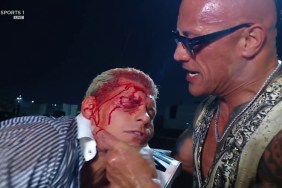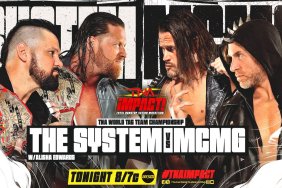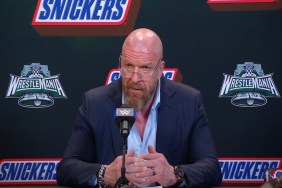Aging is the most widespread fear of today. Afraid of squandering the previous years, the deterioration of their youthful appearance, and the ever-impending punchline to their lives. Some accept the inevitable, allowing the passages of time to flow over and around them whilst they do their own thing. Others choose to fight age, with an endless supply of moisturizers and face creams, gaudy red sport cars, or divorces, people use a whole range of decisions and purchases to seize the moment and keep time at an arms length. Such people suffer from a common form denial regardless of which manifestation they prefer. Whilst fast cars and cosmetic surgery are frequent forms of age denial, a cluster of middle agers have their own variety of denial, returning to the wrestling ring.
During the hype before and briefly after Wrestlemania, fans get caught up in a reflective haze. The flurry of passing on the torch and older stars rotating out of action, viewers are compelled to reminisce to times past littered with nostalgic moments that outline a basic wrestling timeline. Sometimes they can’t help themselves, sporting rose coloured glasses, and seeing the veteran stars for what they were in the best of times, not for what they are now. This unquenchable thirst for yesteryear stars has seen an army of retired potbellied stars march back in between the ropes under a blanket of rose-coloured light.
Bringing back stars of yore is often seen as selfish and unsustainable business management. Selfish because said aged stars, on the whole, sit quite firmly atop their high horse, perceiving themselves as superior to the locker room full of up and comers. In saying this, due to the demand by fans themselves, veterans are put squarely in the spotlight, given title shots and more than ample television time, and so the product eventually becomes self-indulgent, similar to what caused the untimely demise of WCW. Unsustainable because by allowing the two hours to be clogged with hedonistic long winded promos, little time is left for other young athletes to reach the same heights as the veterans. In the short term, fans will be reveling in the ‘old school’ nostalgia of seeing their childhood heroes back in the ring, but in the long term the aged wrestlers will not be able to sustain the schedule demanded of them and thus falling off the radar again, but this time permanently. If a company has developed a dependency on wistful memories and the memories then leave to reside in a Middle-American nursing home, they are left with a team consisting of unknown and inexperienced rookies.
All modern wrestling productions have a dependency on veteran recognisability to some degree. Be it to elevate new stars or to generate interest in a fledgling company, the reliance is so ingrained that there is no practical way to weed it out. In some regard, up until the prologue to Wrestlemania, the WWE had significantly toned down its use of old stars. In previous years, ‘stars’ such as, Steiner, the NWO, and Goldberg were brought into the company to contend for the top spots, the rest of the locker room playing second string. Veteran presence is essential, but the key is to balance the old talent with the new talent.
One of the difficulties of having both veterans and young stars in the same company is that when they square off against one another, it results in one having to losing a significant amount of face for the match to be credible. There is no chance of a win-win situation. Either the veteran gets defeated and all childhood ambrosia is dispelled, or the young star gets defeated putting a damper on their rise to fame, and essentially not ‘passing the torch’. In the past, the solution for such an issue has been to separate both entities. The legends fight amongst the older of the current stars, while the young stars battle between each other. This partition of the roster means that the younger stars often lose out because the older stars are dominating the spotlight with an unofficial ‘legends’ division.
Suggestions have circulated concerning officially identifying a ‘legends’ division, title and all. Such a division would have great ramifications with the remainder of the company, and is one of the sole reasons why deeper thought hasn’t been put into its fruition. Disadvantages are always uncovered promptly following such a groundbreaking proposal, often failing to remember why the submission was first proposed. Installing a sect where only athletes who have performed in the business over twenty years would go far to officialise the nourishment of the nostalgic hunger fans have. Fans each week would be treated to a reminiscent booster shot in the arm as older stars return for their last few moments of glory.
‘The Legends Title’ as it would be called, would be the carrot on a string enticing retired stars to perform in front of the longing fans once again. By having an incentive for the oldies, the company would not be at the will of the middle-aged hedonism that the likes of Hogan and Savage sustain, because retirees will not as much return for the quick buck but the renewed interest in themselves, feeding their egotism.
The chief basis why such a title would be created is simply because fans demand it. The product is made for the viewers; so in order to satisfy them wholly why not listen to their cries. Whenever a star returns unexpectedly the crowd upsurges in unison with a deafening roar, there are few current stars that receive a similar reaction.
But the fans don’t know what’s good for them. While it may be fine and dandy to say that ‘the fans are always right’, some sort of control must exist, because the crowds want a good show, and on the whole, are clueless as to the inner mechanics of the business. If a legend were to compete each week for months on end, the hype would tailspin until the show is left with a balding grandfather-to-be stumbling to the ring in dead silence. Too much of a good thing can be a bad thing. The reason why legends gather such an uproar is the intensity of the moment, the outburst of emotions, and the instant of childhood memories. No time is allowed for fans to remember why they think this; they ride the flow of united passion produced by the crowd around them. However, if the golden boy stays, and does his or her best to provide the audience with barely above two star matches, the fans, in their boredom, have the time to remember that the old men in the ring weren’t much better the first time around.
The hype surrounding such a division would be overwhelming, absorbing all the attention from the current stars. Weeks would pass and the limelight once swam in by the top billing stars of the current decade, would instead be drenching the classic legends biffing over the new-fangled title. Eventually, Wrestlemania will be headlined by stars that headlined it twenty years previous.
A ‘Legends Division’ for all its benefits, is a dangerous and volatile concept to toy with. Although it may provide a playground of dreams for legends to play in the sand, but truth be told, there comes a time when a man has to admit defeat. The river of time always wins, no matter how much you try to deny that you’re aging, it will catch up with you. Companies in the past have prioritized veterans over up and comers resulting in catastrophe. The kids are the future. If an ex-star would like to be showered in the spotlight once more, try mentoring a rookie overflowing with potential to stardom.
No ‘legends’ division is needed; the spontaneous appearances are satisfying the audience’s hunger at present. As for the vintage stars themselves, they need to listen to their bodies, the shooting pain as they amble out of bed, the grinding of bone on bone as they crouch, and the muscle morphing into flab, its saying that your prime is in the past. Blow the dust off the box of tapes, and spend an afternoon observing all that they’ve achieved.
If you want to send feedback or an email, my address is TheButchershopColumn@hotmail.com. All mail is appreciated and answered promptly.
Over and Out
The Butcher








